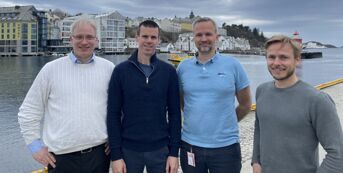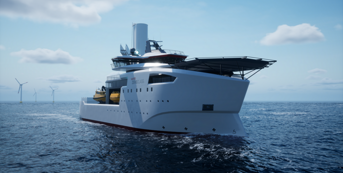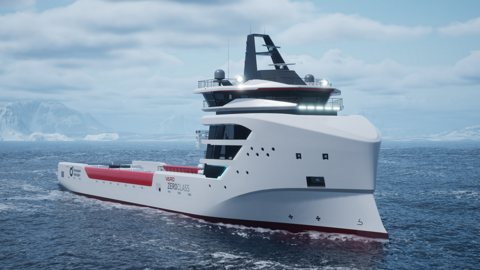The next generation PSV concept
- It's about reducing energy consumption for the mission the vessel will do, says Thomas Olsvik, VP Conceptual Design at Vard Design.
The green transition refers to the period after we realize that the way we live is not sustainable, until our actions no longer negatively affect the planet. VARD will lead this transition in our industry.
23. May 2023
The genuine desire to build ships for the future has been with VARD for a number of years. This is precisely why we have a long tradition of initiating research projects that create value far beyond our own company.
- Research projects are a great opportunity to lift our glance and see what barriers we face in the green transition, explains Henrik Burvang, Research & Innovation Manager at Vard Design.
- Norwegian shipowners are incredibly keen to find new solutions.
That said, there are many ways into a research project. Håvard Vollset Lien, Vice President Research & Innovation at Vard Group, explains how collaboration across disciplines and companies helps push development forward.
- A research project can just as easily be the result of a need or a challenge from a shipping company as someone in our own organization seeing an opportunity. Norwegian shipowners are incredibly keen to find new solutions and we see great value in the projects we do together with them, he explains.
Thomas Brathaug is Principal Naval Architect Conceptual Design at Vard Design. He also highlights research projects as crucial for leading the green transition.
- For us to be able to see the totality of technology development, it is important that we are in the driver's seat in our own competence enhancement, Thomas explains.
One of the research projects involving several different parties from both VARD, the shipping companies and the research communities, is PIEZO.
- We saw a great need to develop precise digital simulations of energy systems, and a great potential within electrification and utilization of large battery packages in the offshore market. With PIEZO, we got a useful arena to research both these development aspects in parallel, says Henrik Burvang.
This is, of course, music to the ears of battery supplier Corvus, one of several partners in the research project. In addition, Equinor and Solstad are important partners.
- Solstad and Equinor have a great interest in the electric PSV concept and the infrastructure of charging offshore, and have been important contributors when it comes to the operational perspective. They spar with us on the concept and solutions and give us feedback on what is realistic, Henrik explains.
In addition, Solstad has made ships available for the data collection forming the basis for the research.
Much of the research has taken place at VARD and SINTEF. The result is a digital twin that behaves identically to Solstad's PSV.
-Tim Mak of Vard Design has developed the digital simulation model, which has now been verified by collected data over two years. Furthermore, we have developed a new model based on battery-electric propulsion, says Burvang.
- Using as little energy as possible is crucial for zero-emission ships. With simulations like this, we will be able to get a full overview of the energy flow in the ship before building it, and that is one of the reasons why this simulation model is a potentially powerful tool for future projects.
- We see that the concept of battery-electric PSVs is feasible and if we also realize offshore charging, this will be very attractive for the offshore and renewables market. The research project PIEZO has undoubtedly helped lay the foundation for our new all-electric PSV concept, Henrik states.
Thomas Olsvik has worked with design at VARD since 2011. He is currently VP Conceptual Design at Vard Design.
- There is a long process behind what will now be a zero-emission ship. Even before we started looking at fuel, we had been working for several years on the next generation PSV concept. This includes major improvements in propulsion and hull resistance. Because regardless of the fuel, it's about reducing energy consumption for the mission the vessel will do, Olsvik explains.
Hull optimization is an important part of this work. Therefore, VARD has developed a tool that ensures greater understanding among both the customer and others involved.
-The tool makes it possible to optimize the hull design early in the project. Thus, the hull design can be optimized for the operation the customer will perform. This means that we can sit down with the customer and show how the choices they make will affect their energy consumption, says Thomas Brathaug.
However, hull optimization alone is not enough. All design disciplines at VARD have a great responsibility to reduce energy consumption.
-The hull development has become very good, but there are several other things we need to look at - both we at VARD and those who will use the ship. Many PSVs are too big, and we have a lot of improvement to do when it comes to, for example, interior design, operation, and other support systems. In the future, I think we will see more specialized PSVs, says Olsvik.
The next generation PSV concept
- It's about reducing energy consumption for the mission the vessel will do, says Thomas Olsvik, VP Conceptual Design at Vard Design.
When it comes to zero-emission ships, there are also several other demanding factors that come into play. Among other things, the new energy carriers are very space-consuming.
- A common denominator for all the new energy carriers is that they take up significantly more space than traditional marine diesel oil. We can't fill the whole vessel with batteries or green fuel. This means that the vessel must refuel or charge much more often than before, and to compensate for this, we must ensure that the ship uses as little energy as possible,
Brathaug explains.
This applies whether the ship will receive energy from batteries, hydrogen, ammonia, or other energy carriers.
- Another challenge is the lack of excess heat. The heat needed must therefore be made in other ways. This means that we as designers need to be more involved in the whole process. Because it's not just propulsion that needs energy. So do all the other processes on board, says Olsvik.
Combined with a lack of regulations and infrastructure, leading innovation is not always easy. This makes it even more interesting, according to Thomas Olsvik:
- It is very rewarding to be part of defining the new standards together with our customers. We get the opportunity to influence the direction of an entire industry and that is incredibly exciting, he states.
Thomas Brathaug and the rest of the design team have worked closely with the team in Research & Innovation in the PIEZO project. According to Brathaug, the interdisciplinary collaboration is essential to ensure that VARD looks further ahead than the individual projects. The ability to look ahead is also one of the reasons why VARD has continued to research the offshore market, despite the recession.
- We always believed that the offshore market would recover, the question was just when. Therefore, it has been important for us to maintain competence and keep up with trends in the market. This means that we can offer customers future solutions when the market is back, he says.
So, when can we really expect to see an all-electric PSV in operation? Thomas Olsvik is cautious about making promises, but if things go according to plan, it doesn't have to take more than three years.
-The technology is there. Now it's just a matter of finding the balance in terms of finances, range, and so on. In theory, we could see an all-electric PSV in operation earlier, but it must work out for both tenant and shipowner. Either way, we at VARD are ready, says Olsvik.


